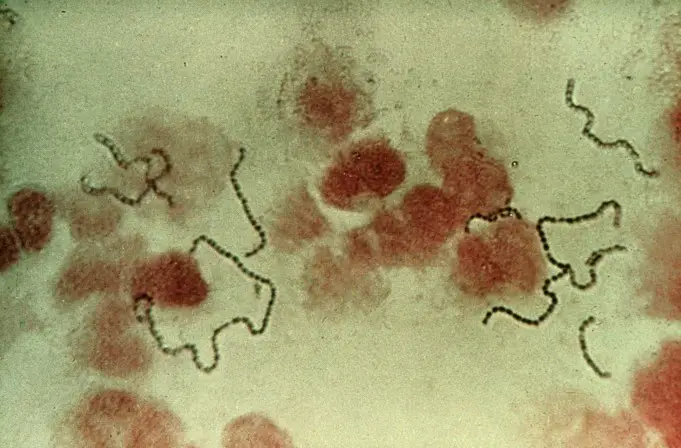Erysipeloid is a rare acute infection of the skin caused by non-spore, gram-positive rod bacteria called Erysipelothrix rhusiopathiae. This bacterium is often found in fresh or saltwater fish, shellfish, mammals, birds.
Reported cases are usually people who work closely with the animals mentioned above like farmers, fishermen, cooks/chefs, butchers, grocers or veterinarians. There are also rare reports of non-occupational related cases.
Cases like this have been linked to cat or dog bite. This implies that the bacteria may be part of the oral-floral of these animals. Infections usually occur when there is contact with the bacteria and broken or cut skin.
Another source of infection is soil and contaminated water. Erysipeloid is also known as fish poisoning and Rosenbach. The bacteria can survive outside their aquatic environment.
They can persist in soil for a long time. They can also grow on exterior mucoid of the slime of fish without causing harm or infection to the host. It is however not resistant to heat and can be killed by heat at 55 degrees centigrade for 15 minutes.
It is resistant to other methods of food preservation like smoking, salting and pickling.
Individuals with compromised immunity or in poor health are more likely to develop a more severe form of infection and other complications such as long-term valvular heart disease, septic arthritis with long term joint diseases and permanent neurological damage.
Areas of infections are usually the fingers, web of fingers, hand or forearm. Lesions appear within 2 to 3 days of infection. If untreated, Erysipeloid is self-resolving and often gets better on its own between 2-4 weeks, but antibiotics can be used to accelerate healing.
However, if this bacterium escapes immune surveillance, it may spread to other organs causing further health complications.
Symptoms
Erysipeloid can occur in people in different ways, and the most common and least severe form is “localised cutaneous Erysipeloid”, a self-limiting disease with the following characteristics:
- Shiny and smooth red or purple surface of the affected area. they lesions may expand slowly over a few days which may have tiny blisters
- Fluid-filled blisters
- The affected area may be warm and tender and cause a throbbing pain, itchy or burning sensations
- In a few cases, there are reports of mild fever and chills
- Affected areas are usually the hands, fingers, web of fingers, hand, forearms or any other area that had direct contact with the bacteria
- Although very uncommon, a diffuse cutaneous form of Erysipeloid develops when multiple lesions show on various parts of the body
Another form of infection is the “diffuse cutaneous infection”. It is characterised by a well-demarcated lesion. Individuals who have this form of Erysipeloid experience symptoms like:
- Fever
- Malaise
- Joint pain
Other ways erysipeloid can occur is through its most severe form called Systemic Erysipeliod.
This is when other organs such as the heart, the brain, joints and lungs get infected. Individuals who have Systemic Erysipeloid may experience the following symptoms:
- Fever
- Chills
- Headache
- Weight loss
- Joint pain
Skin lesions may or may not be evident in patients with systemic erysipeloid.
Prevention
- Using gloves and protective hardware while handling fish or meat can help minimise the risks of getting infected
- Usage of disinfectants on hard surface eliminates the bacteria. This is a productive way to prevent infection
- Frequent washing of hands with soap or usage of alcohol-based hand drop
- Treatment of skin injuries no matter how small
Diagnosis
Diagnosis is often made when the doctor examines the patient. The health care provider examines and asks how and when the symptoms started. Further tests can be carried out for accurate diagnosis.
Tests like skin biopsy and culture to check for the bacteria can be conducted. You may also be required to run some blood tests to check how far the infection has spread into the body
Treatment
Erysipeloid is self-limiting and usually goes away on its own between two to four weeks. However, antibiotics can hasten the healing process and reduce the odds of infection spreading to other organs.
A single dose of a medication known as Benzathine benzylpenicillin given by intermuscular injection can be effective. An oral dose of Penicillin can be administered to remedy the infection.
Drugs like Erythromycin or rifampicin can be applied to patients who have allergic reactions to Penicillin. Erysipeloid is also susceptible to doxycycline, tetracycline, and ciprofloxacin.
It is also known to be resistant to sulphonamides and trimethoprim-sulfamethoxazole but inherently resistant to vancomycin. The medications, as mentioned above, are only for informational purposes.
If you notice any symptoms, contact a healthcare provider. The immediate diagnosis and early treatment of severe systemic erysipeloid are essential in preventing serious or fatal complications.
In rare cases of endocarditis, it is vital to consult a cardiologist and a cardiothoracic surgeon. The surgical procedure is not recommended as even the simplest incision on the lesion can prolong the recovery time.
However, patients with endocarditis may undergo surgery like cardiac valve replacement or other procedures depending on the organs that are affected.
Sources;
Erysipeloid – emedicine.medscape













is this sickness deadly Than corona virus? i just want to know. Love your article